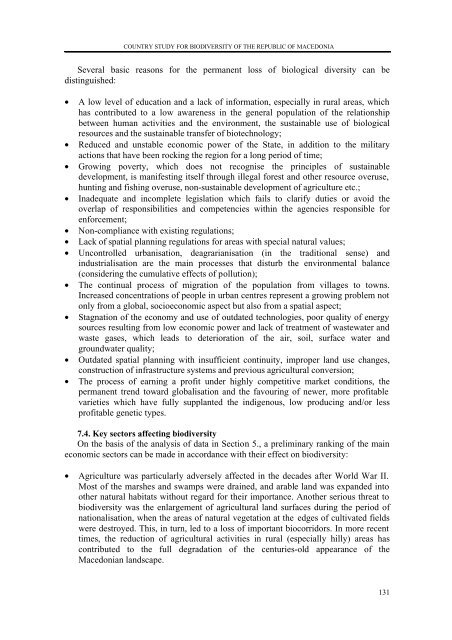English - Convention on Biological Diversity
English - Convention on Biological Diversity
English - Convention on Biological Diversity
Create successful ePaper yourself
Turn your PDF publications into a flip-book with our unique Google optimized e-Paper software.
COUNTRY STUDY FOR BIODIVERSITY OF THE REPUBLIC OF MACEDONIA<br />
Several basic reas<strong>on</strong>s for the permanent loss of biological diversity can be<br />
distinguished:<br />
• A low level of educati<strong>on</strong> and a lack of informati<strong>on</strong>, especially in rural areas, which<br />
has c<strong>on</strong>tributed to a low awareness in the general populati<strong>on</strong> of the relati<strong>on</strong>ship<br />
between human activities and the envir<strong>on</strong>ment, the sustainable use of biological<br />
resources and the sustainable transfer of biotechnology;<br />
• Reduced and unstable ec<strong>on</strong>omic power of the State, in additi<strong>on</strong> to the military<br />
acti<strong>on</strong>s that have been rocking the regi<strong>on</strong> for a l<strong>on</strong>g period of time;<br />
• Growing poverty, which does not recognise the principles of sustainable<br />
development, is manifesting itself through illegal forest and other resource overuse,<br />
hunting and fishing overuse, n<strong>on</strong>-sustainable development of agriculture etc.;<br />
• Inadequate and incomplete legislati<strong>on</strong> which fails to clarify duties or avoid the<br />
overlap of resp<strong>on</strong>sibilities and competencies within the agencies resp<strong>on</strong>sible for<br />
enforcement;<br />
• N<strong>on</strong>-compliance with existing regulati<strong>on</strong>s;<br />
• Lack of spatial planning regulati<strong>on</strong>s for areas with special natural values;<br />
• Unc<strong>on</strong>trolled urbanisati<strong>on</strong>, deagrarianisati<strong>on</strong> (in the traditi<strong>on</strong>al sense) and<br />
industrialisati<strong>on</strong> are the main processes that disturb the envir<strong>on</strong>mental balance<br />
(c<strong>on</strong>sidering the cumulative effects of polluti<strong>on</strong>);<br />
• The c<strong>on</strong>tinual process of migrati<strong>on</strong> of the populati<strong>on</strong> from villages to towns.<br />
Increased c<strong>on</strong>centrati<strong>on</strong>s of people in urban centres represent a growing problem not<br />
<strong>on</strong>ly from a global, socioec<strong>on</strong>omic aspect but also from a spatial aspect;<br />
• Stagnati<strong>on</strong> of the ec<strong>on</strong>omy and use of outdated technologies, poor quality of energy<br />
sources resulting from low ec<strong>on</strong>omic power and lack of treatment of wastewater and<br />
waste gases, which leads to deteriorati<strong>on</strong> of the air, soil, surface water and<br />
groundwater quality;<br />
• Outdated spatial planning with insufficient c<strong>on</strong>tinuity, improper land use changes,<br />
c<strong>on</strong>structi<strong>on</strong> of infrastructure systems and previous agricultural c<strong>on</strong>versi<strong>on</strong>;<br />
• The process of earning a profit under highly competitive market c<strong>on</strong>diti<strong>on</strong>s, the<br />
permanent trend toward globalisati<strong>on</strong> and the favouring of newer, more profitable<br />
varieties which have fully supplanted the indigenous, low producing and/or less<br />
profitable genetic types.<br />
7.4. Key sectors affecting biodiversity<br />
On the basis of the analysis of data in Secti<strong>on</strong> 5., a preliminary ranking of the main<br />
ec<strong>on</strong>omic sectors can be made in accordance with their effect <strong>on</strong> biodiversity:<br />
• Agriculture was particularly adversely affected in the decades after World War II.<br />
Most of the marshes and swamps were drained, and arable land was expanded into<br />
other natural habitats without regard for their importance. Another serious threat to<br />
biodiversity was the enlargement of agricultural land surfaces during the period of<br />
nati<strong>on</strong>alisati<strong>on</strong>, when the areas of natural vegetati<strong>on</strong> at the edges of cultivated fields<br />
were destroyed. This, in turn, led to a loss of important biocorridors. In more recent<br />
times, the reducti<strong>on</strong> of agricultural activities in rural (especially hilly) areas has<br />
c<strong>on</strong>tributed to the full degradati<strong>on</strong> of the centuries-old appearance of the<br />
Maced<strong>on</strong>ian landscape.<br />
131
















